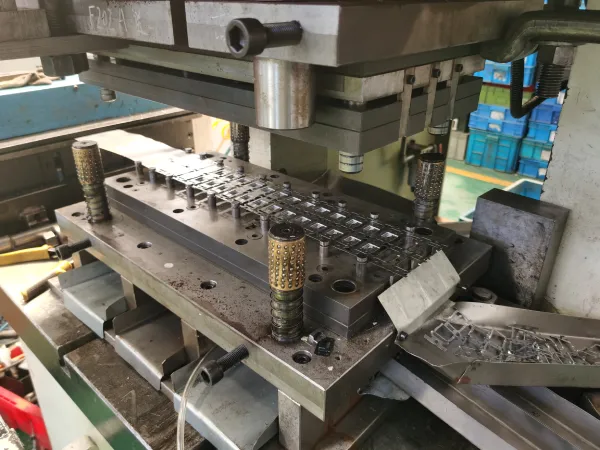The Advancement of Metal Stamping Procedures: Advancements and Applications
The realm of steel marking processes has actually seen a transformative trip marked by continuous technology and adaptation to satisfy the needs of modern industrial methods. The applications extend across a range of sectors, each benefiting distinctively from the innovations in metal stamping processes.
Standard Steel Stamping Methods
Standard steel marking techniques have long been the foundation of producing procedures in numerous sectors due to their efficiency and precision. The process includes creating a steel sheet or coil right into a desired shape by pressing it between a die and a punch. This method is commonly made use of for generating huge amounts of components with high accuracy at a quick speed.
Among the crucial benefits of standard steel marking methods is the capability to keep tight tolerances, guaranteeing that each part meets the required specifications consistently. This level of precision is necessary in markets such as vehicle, aerospace, and electronics, where even minor deviations can bring about significant issues.
Furthermore, traditional steel marking methods supply cost-efficient solutions for automation contrasted to various other producing methods. The capacity to mark parts in fast sequence lessens production time and reduces labor prices, making it an appealing option for businesses wanting to optimize their production processes.
Emergence of High-Speed Stamping

One of the vital advantages of high-speed marking is its capacity to preserve accuracy and consistency even at increased processing rates. This accuracy is critical in sectors where tight resistances and intricate styles are called for. Furthermore, high-speed marking permits for the handling of a variety of materials, consisting of aluminum, stainless steel, and copper, additional expanding its applicability throughout various markets.
Furthermore, the development of high-speed marking has actually enabled manufacturers to satisfy the expanding need for complex components in markets such as auto, aerospace, and electronic devices (Metal Stamping). By leveraging the speed and precision of high-speed marking technology, companies can enhance their competitiveness in a quickly advancing market landscape
Advancements in Tooling Modern Technology
With the evolution of high-speed marking making it possible for improved precision and effectiveness in metal forming procedures, the field of metal marking has actually seen significant advancements in tooling technology. Tooling technology plays a crucial duty in metal stamping procedures, influencing factors such as item top quality, manufacturing speed, and total cost-effectiveness.
Moreover, developments in products science have actually resulted in the production of tooling products with enhanced durability, use resistance, and thermal conductivity. By utilizing these innovative materials, tooling suppliers can generate passes away and molds that stand up to the high pressures and temperature levels involved in steel stamping procedures, leading to longer device life and enhanced manufacturing efficiency. Furthermore, innovations in device design, such as using simulation software application and additive production methods, have actually enabled the development of intricate tooling geometries that were previously testing to generate. On the whole, these innovations in tooling technology have revolutionized the metal marking industry, enabling suppliers to achieve greater degrees of precision, productivity, and expense financial savings.
Assimilation of Automation in Marking
As automation remains to reshape the landscape of metal stamping procedures, the assimilation of automated systems has actually ended up being significantly widespread in modern-day production facilities. Automated systems offer various benefits in metal stamping, consisting of raised performance, boosted precision, and boosted safety. By including automation right into stamping processes, manufacturers can reduce cycle times, minimize product waste, and optimize manufacturing throughput.
One of the key parts of automation in stamping is the usage of robot arms for tasks such as material handling, part adjustment, and high quality evaluation (Metal Stamping). These robot systems can do repetitive and labor-intensive jobs with speed and precision, releasing up human operators to concentrate on more intricate operations. Additionally, automation enables visite site real-time monitoring and adjustment of marking processes, bring about higher total process control and top quality assurance
In addition, the assimilation of automation in stamping makes it possible for producers to attain consistent component quality, satisfy limited resistances, and enhance total performance. As technology proceeds to breakthrough, the role of automation in metal stamping processes is anticipated to broaden additionally, driving technology and effectiveness in the production industry.
Applications Throughout Diverse Industries
Integrating metal stamping processes throughout varied markets showcases the adaptability and flexibility of this click to read more production strategy. Furthermore, the appliance sector benefits from steel stamping processes to make parts for refrigerators, cleaning devices, and various other home appliances. The versatility of metal stamping procedures makes it an important production method across various industries, demonstrating its relevance in contemporary manufacturing procedures.
Verdict

Comments on “Metal Stamping Processes: From Prototyping to Mass Production”